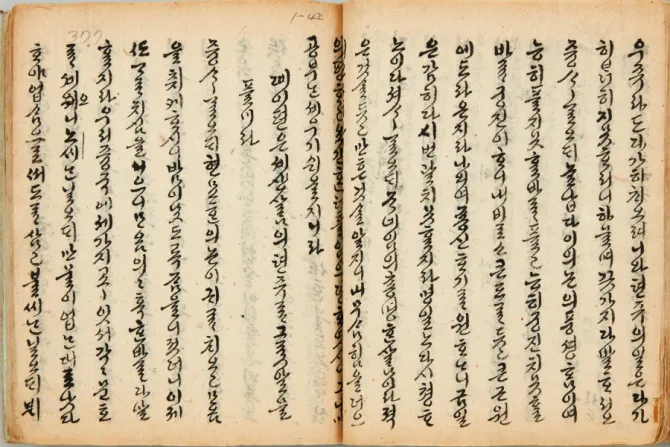Vatican City, Sep 20, 2017 / 05:04 am
An exhibit at the Vatican this month shows the 230-year history of the Catholic Church on the Korean peninsula, highlighting the faith of its martyrs and promoting a message of peace.
Fr. Matthias Hur Young-yup , a spokesperson of the Archdiocese of Seoul, told CNA that with the exhibit they want to promote peace and teach people about Korean culture.
"As you know there is a nuclear crisis going on in the Korean peninsula, and through this exhibition we wanted to deliver a peace message, especially to our brothers and sisters in the North," Fr. Hur said.
The exhibit, called "Come in cielo cosi in terra" ("On earth as it is in heaven"), is a first-ever collaboration between the Vatican Museums and the Seoul archdiocese. It is also sponsored by the Seoul Metropolitan Government and the South Korean embassy to the Holy See.
It opened in the Vatican's Braccio di Carlo Magno museum Sept. 8.
The archdiocese also hopes the exhibit will "introduce the unique history and culture of the Korean Catholic Church worldwide, and to take a step forward to fulfill our mission of the evangelization of Asia."
The exhibit is "only a part of the different projects" on which Korea and the Holy See are partnering, Barbara Jatta, director of the Vatican Museums, told CNA. In 2012, the Vatican Museums sent Renaissance pieces by artists such as Michelangelo and Raphael for an exhibit in Seoul.
They are also working on several restoration projects within the ethnological museum. But "this is the first time that Koreans expose, in the heart of the Vatican City State, their own history," she said.
She hopes the exhibit will "show how evangelization can bring peace and more evangelization, and (that) even persecution is not an obstacle to that."
Korean martyrs & other works at the "Come in cielo così in terra" exhibit at the #Vatican showing history of the #Catholic Church in Korea pic.twitter.com/svmIeXagAF
- Hannah Brockhaus (@HannahBrockhaus) September 19, 2017
The Catholic faith was originally introduced to Korea through Catholic books brought to the country from Beijing. A group of scholars studied the books, from them developing a belief in the Catholic faith. One scholar was baptized in Beijing in 1784, returning to Korea to baptize others.
These scholars formed the first Catholic community in the country.
"As the number of believers increased, they discovered that it was not a very good way, to just spread the faith among the lay people," Fr. Hur explained. "So that is when they decided to ask for a missionary, a priest, to come to Korea for a more formal evangelization of the country."
He said that it is very significant to the members of the Church in Korea that Catholicism in their country was begun by lay people.
As they waited for a priest, the faith continued to grow among the lay people, until finally in 1794 they received a missionary priest from Beijing.
(Story continues below)
But even before this, persecution of Christians in Korea had begun. From the beginning of her history, the Church in Korea has been marked with suffering, including a century of religious persecution resulting in the martyrdom of at least 8,000 Catholics.
"With the 230 years of history in Korea, we believe especially that we have been through all the persecutions and we didn't die…but we prospered. Especially that the martyrs have become a good role model for all believers…that is the best fruit that has appeared in the country of Korea," Fr. Hur said.
This exhibit "is not only a very good chance for us to introduce the history of the Korean Catholic Church, but also the culture and the special characteristics of the Korean country itself. I believe that this is a very good introduction for the world to our Korean culture."
The exhibit outlines, chronologically, the history of Catholicism in Korea from its start through the present time. It includes religious books and objects, as well as Korean religious art.
There are many beautiful works depicting the Madonna and Child, as well as portraits of the martyrs from throughout their history.
Blessed Feast of the Nativity of Mary! (Our Lady as a Korean Madonna and Child, part of an exhibit on the Korean Church now at the Vatican) pic.twitter.com/Cq4oAVGiAo
- Hannah Brockhaus (@HannahBrockhaus) September 8, 2017
Despite persecution, the Catholic population in Korea has continued to grow; in the 1950s they had only 500,000 Catholics (about two percent of the population). As of 2016 there are nearly 6 million (10 percent of the total population).
In the 1950s they only had 290 priests. Today they have approximately 5,100.
Pope Francis visited Korea in August 2014, his first pastoral visit to an Asian country. While there he beatified 230 martyrs during a Mass in Gwanghwamun, with around 1 million people present.
Pope St. John Paul II was the first Pope to visit South Korea when he went to Seoul in May 1984, marking the 200th anniversary of the Church in Korea. During his visit he presided over the canonization of 103 Korean martyrs, the first canonization ever celebrated outside the Vatican.
He again visited South Korea in 1989 to participate in the 44th International Eucharistic Congress in Seoul. And in 2001, during an ad limina visit of the Korean bishops at the Vatican, he said that "inter-Korean reconciliation and solidarity and the evangelization of Asia is the mission of the Korean Church."
Fr. Hur said through the exhibit they want people to know that no one on the Korean peninsula wants war, but that peace is what they really want.
"That is the message we wanted to share with all the people through this exhibition and we hope that all the people will pray for us and for peace on the Korean peninsula."



